AMD Phenom II X4 980 Black Edition Review
by Anand Lal Shimpi on May 2, 2011 10:42 PM ESTGaming Performance
In testing Left 4 Dead we use a custom recorded timedemo. We run on a GeForce GTX 280 at 1680 x 1050 with all quality options set to high. No AA/AF enabled.
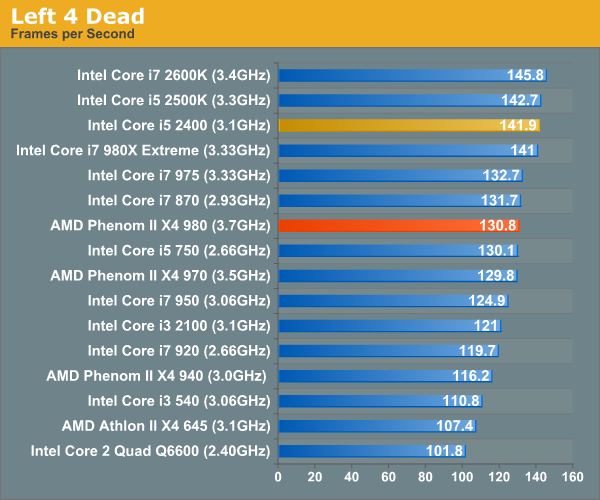
Far Cry 2 ships with several built in benchmarks. For this test we use the Playback (Action) demo at 1680 x 1050 in DX9 mode on a GTX 280. The game is set to medium defaults with performance options set to high.
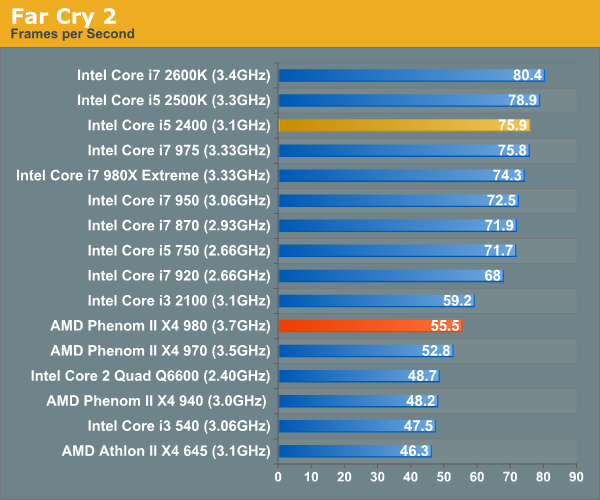
Crysis Warhead also ships with a number of built in benchmarks. Running on a GTX 280 at 1680 x 1050 we run the ambush timedemo with mainstream quality settings. Physics is set to enthusiast however to further stress the CPU.
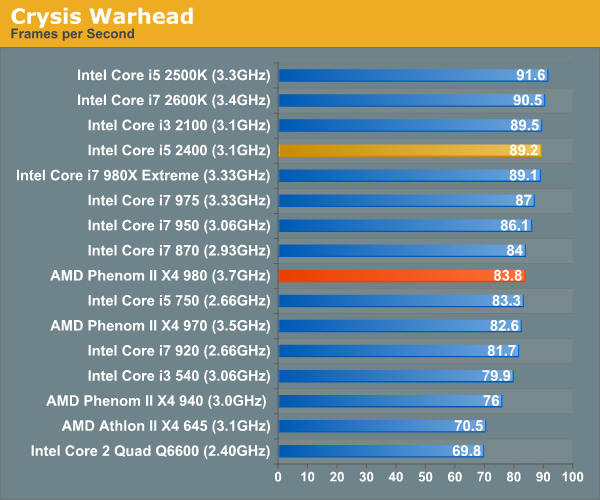
Our Dragon Age: Origins benchmark begins with a shift to the Radeon HD 5870. From this point on these games are run under our Bench refresh testbed under Windows 7 x64. Our benchmark here is the same thing we ran in our integrated graphics tests - a quick FRAPS walkthrough inside a castle. The game is run at 1680 x 1050 at high quality and texture options.
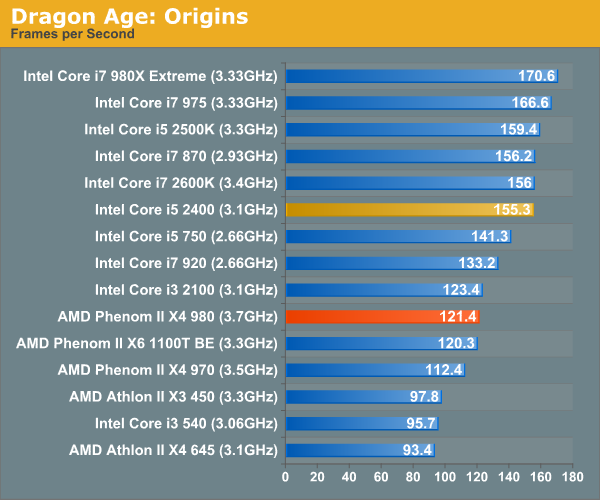
We're running Dawn of War II's internal benchmark at high quality defaults. Our GPU of choice is a Radeon HD 5870 running at 1680 x 1050.
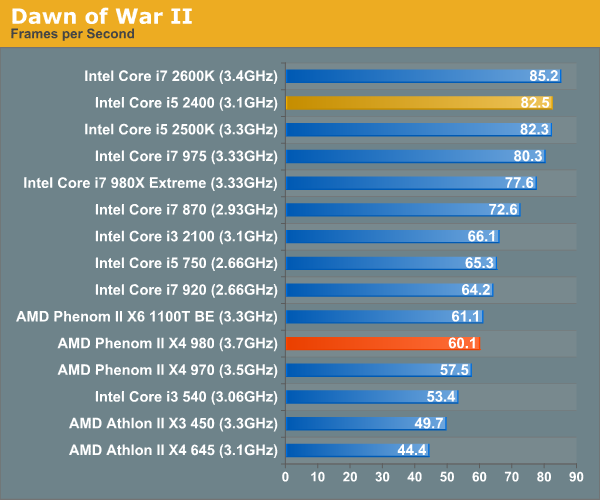
Our World of Warcraft benchmark is a manual FRAPS runthrough of a lightly populated server with no other player controlled characters around. The frame rates here are higher than you'd see in a real world scenario, but the relative comparison between CPUs is accurate.
We run on a Radeon HD 5870 at 1680 x 1050. We're using WoW's high quality defaults but with weather intensity turned down all the way.
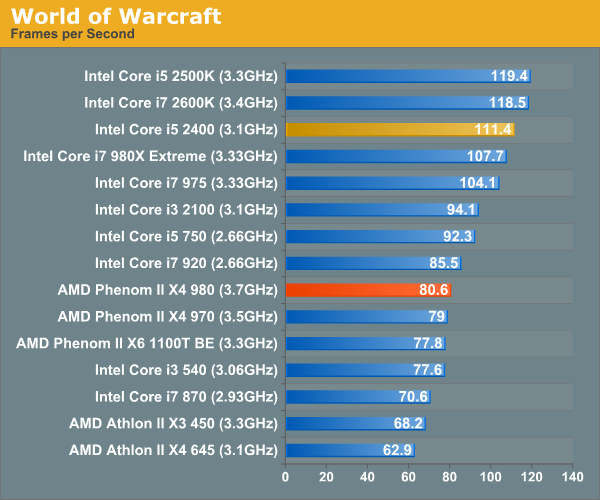
For Starcraft II we're using our heavy CPU test. This is a playback of a 3v3 match where all players gather in the middle of the map for one large, unit-heavy battle. While GPU plays a role here, we're mostly CPU bound. The Radeon HD 5870 is running at 1024 x 768 at medium quality settings to make this an even more pure CPU benchmark.

This is Civ V's built in Late GameView benchmark, the newest addition to our gaming test suite. The benchmark outputs three scores: a full render score, a no-shadow render score and a no-render score. We present the first and the last, acting as a GPU and CPU benchmark respectively.
We're running at 1680 x 1050 with all quality settings set to high. For this test we're using a brand new testbed with 8GB of memory and a GeForce GTX 580.
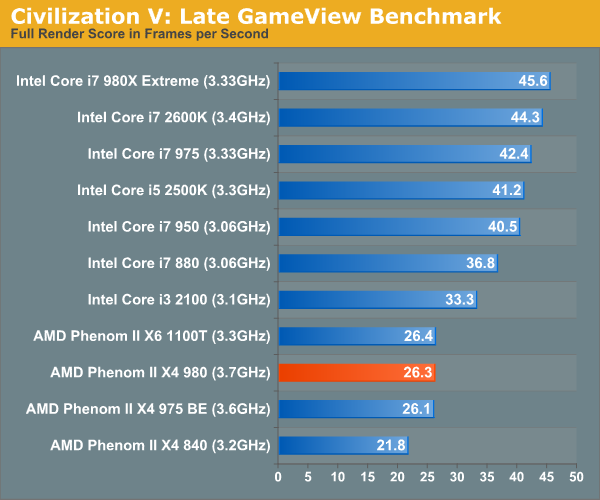
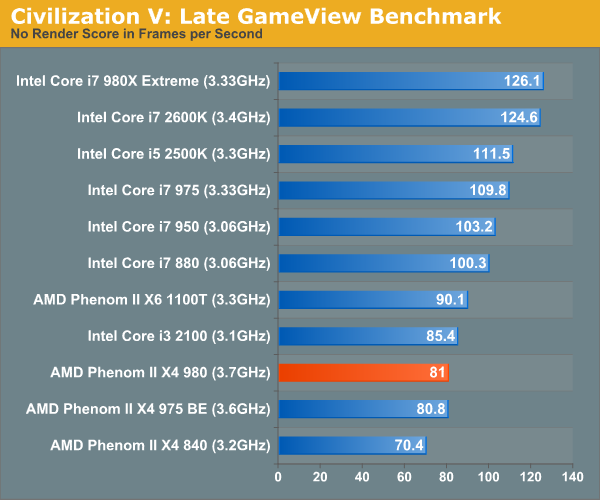










78 Comments
View All Comments
rfle500 - Tuesday, May 3, 2011 - link
I'm glad to see a compile test in the lineup. Can I ask - how did you choose number of threads for the test - was it the same for all (12) or based on number of physical, or hyperthreaded cores. In my experience, on AMD chips most compilations are faster with overloaded threads, say 2x number of physical cores - did you test this possibility?silverblue - Thursday, May 5, 2011 - link
Some programs don't work well with non-power-of-2 architectures either, which would harm performance of the X3 and X6 processors (Windows Media Encoder 9), or even worse, cripple things completely (DivX or XviD on VirtualDub uses just one of an X3's cores, so you need to set the affinity to two cores). I suppose logically, overstressing a hyperthreaded CPU would mean that the its execution units are fully utilised and, as such, logical cores won't actually make any difference, so it would be in these situations where the X6 could perhaps close the gap a little.Shadowmaster625 - Tuesday, May 3, 2011 - link
It also gives them an opportunity to remove millions of wasted cpu cycles.krumme - Tuesday, May 3, 2011 - link
Man this is some boring news. I would prefer to get some more inside or backgroud info from AMD, Intel or Arm country, even if it takes years compared to this. But i guess this is better business :)greenguy - Tuesday, May 3, 2011 - link
I keep checking here looking for the inevitable Llano review, but it's not here yet. How long do we have to wait?Action_Parsnip - Tuesday, May 3, 2011 - link
It appears you would like to marry Francois Piednoel?jabber - Wednesday, May 4, 2011 - link
Who is Francois Pedofile?Never heard of him.
529th - Tuesday, May 3, 2011 - link
I don't see this mentioned in the review nor the benchmarks, someone correct me if I am wrong but when those benches are made, are they made with Turbo disabled? If not, I don't see it as a fair comparison if you are running stock speeds when comparing a 3.3Ghz i7 2500K vs a 3.33Ghz i7 975 You have games that make use of all cores, and some that use only a few.. so you may get a higher turbo on a Sandy Bridge chip. This is not exact science but making the GHz speed into an exact comparison without Turbo enabled gives a little more insight into the product..just sayin
PubFiction - Tuesday, May 3, 2011 - link
This is just a final release to cap off Phenom 2 they know they were beat they are just giving a little speed boost to it for more value. If this was bulldozer then ya it would be bad but we already know what phenom 2 has to offer why is there so much discussion around a final revision chip. They are just throwing out what may be the most speed they can with that core until BD arrives.Casper42 - Wednesday, May 4, 2011 - link
"AMD originally introduced the Phenom II architecture over two years ago to compete with Intel's Core 2 lineup. Intel has since been through one major microarchitecture revision (Sandy Bridge) and Phenom II is beginning to show its age."Am I missing something or just not counting properly.
Phenom II introduced to compete with Core 2
Intel then Introduces Nehalem/Westmere
Intel then Introduces Sandy Bridge
So wouldn't Intel have been through 2 major architecture revisions?